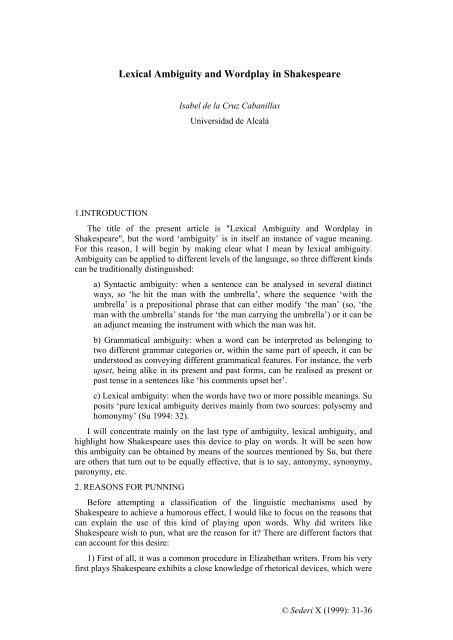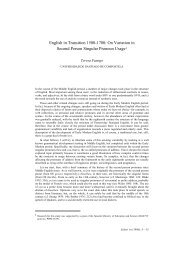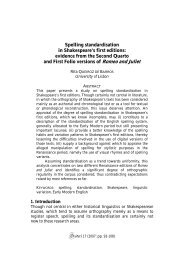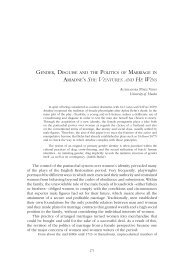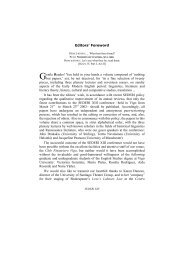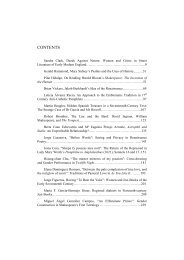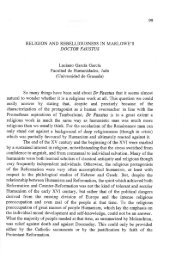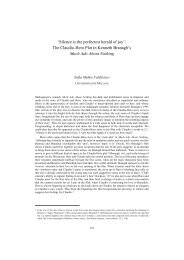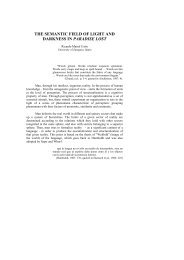Lexical Ambiguity and Wordplay in Shakespeare - SEDERI
Lexical Ambiguity and Wordplay in Shakespeare - SEDERI
Lexical Ambiguity and Wordplay in Shakespeare - SEDERI
You also want an ePaper? Increase the reach of your titles
YUMPU automatically turns print PDFs into web optimized ePapers that Google loves.
<strong>Lexical</strong> <strong>Ambiguity</strong> <strong>and</strong> <strong>Wordplay</strong> <strong>in</strong> <strong>Shakespeare</strong><br />
Isabel de la Cruz Cabanillas<br />
Universidad de Alcalá<br />
1.INTRODUCTION<br />
The title of the present article is "<strong>Lexical</strong> <strong>Ambiguity</strong> <strong>and</strong> <strong>Wordplay</strong> <strong>in</strong><br />
<strong>Shakespeare</strong>", but the word ‘ambiguity’ is <strong>in</strong> itself an <strong>in</strong>stance of vague mean<strong>in</strong>g.<br />
For this reason, I will beg<strong>in</strong> by mak<strong>in</strong>g clear what I mean by lexical ambiguity.<br />
<strong>Ambiguity</strong> can be applied to different levels of the language, so three different k<strong>in</strong>ds<br />
can be traditionally dist<strong>in</strong>guished:<br />
a) Syntactic ambiguity: when a sentence can be analysed <strong>in</strong> several dist<strong>in</strong>ct<br />
ways, so ‘he hit the man with the umbrella’, where the sequence ‘with the<br />
umbrella’ is a prepositional phrase that can either modify ‘the man’ (so, ‘the<br />
man with the umbrella’ st<strong>and</strong>s for ‘the man carry<strong>in</strong>g the umbrella’) or it can be<br />
an adjunct mean<strong>in</strong>g the <strong>in</strong>strument with which the man was hit.<br />
b) Grammatical ambiguity: when a word can be <strong>in</strong>terpreted as belong<strong>in</strong>g to<br />
two different grammar categories or, with<strong>in</strong> the same part of speech, it can be<br />
understood as convey<strong>in</strong>g different grammatical features. For <strong>in</strong>stance, the verb<br />
upset, be<strong>in</strong>g alike <strong>in</strong> its present <strong>and</strong> past forms, can be realised as present or<br />
past tense <strong>in</strong> a sentences like ‘his comments upset her’.<br />
c) <strong>Lexical</strong> ambiguity: when the words have two or more possible mean<strong>in</strong>gs. Su<br />
posits ‘pure lexical ambiguity derives ma<strong>in</strong>ly from two sources: polysemy <strong>and</strong><br />
homonymy’ (Su 1994: 32).<br />
I will concentrate ma<strong>in</strong>ly on the last type of ambiguity, lexical ambiguity, <strong>and</strong><br />
highlight how <strong>Shakespeare</strong> uses this device to play on words. It will be seen how<br />
this ambiguity can be obta<strong>in</strong>ed by means of the sources mentioned by Su, but there<br />
are others that turn out to be equally effective, that is to say, antonymy, synonymy,<br />
paronymy, etc.<br />
2. REASONS FOR PUNNING<br />
Before attempt<strong>in</strong>g a classification of the l<strong>in</strong>guistic mechanisms used by<br />
<strong>Shakespeare</strong> to achieve a humorous effect, I would like to focus on the reasons that<br />
can expla<strong>in</strong> the use of this k<strong>in</strong>d of play<strong>in</strong>g upon words. Why did writers like<br />
<strong>Shakespeare</strong> wish to pun, what are the reason for it? There are different factors that<br />
can account for this desire:<br />
1) First of all, it was a common procedure <strong>in</strong> Elizabethan writers. From his very<br />
first plays <strong>Shakespeare</strong> exhibits a close knowledge of rhetorical devices, which were<br />
© Sederi X (1999): 31-36
ISABEL DE LA CRUZ 32<br />
usually <strong>in</strong>cluded <strong>in</strong> the textbooks of the period, even if this type of humour was<br />
despised later by scholars like Samuel Johnson who claimed a quibble was to<br />
<strong>Shakespeare</strong> ‘the fatal Cleopatra for which he lost the world <strong>and</strong> was content to lose<br />
it’. Despite these op<strong>in</strong>ions, it is nowadays recognised as a major poetic device,<br />
which is comparable <strong>in</strong> its effectiveness with the use of recurrent or clustered<br />
images (Mahood 1988: 11).<br />
Other reasons adduced by Mahood for the use of punn<strong>in</strong>g are:<br />
2) The fact that ‘<strong>Shakespeare</strong> plays with verbal mean<strong>in</strong>gs, not because the<br />
rethoricians approve of wordplay, but because his imag<strong>in</strong>ation as a poet works<br />
through puns, or because his characters are placed <strong>in</strong> situations where it is natural<br />
for them to pun, or because puns help to clarify the particular view of life that he<br />
seeks to present <strong>in</strong> a particular play. <strong>Shakespeare</strong> quibbles as a poet, as a dramatist,<br />
<strong>and</strong> as a dramatic poet; <strong>and</strong> these divisions, though <strong>in</strong> part arbitrary, give us three<br />
means of approach<strong>in</strong>g to the functions of his word play’ (Mahood 1988: 20-21).<br />
3) Thirdly, ‘another psychological function of word play which everyone has<br />
witnessed or experienced is its use to ga<strong>in</strong> relief from a state of emotional tension’<br />
(Mahood 1988: 32). The same view has been followed by other scholars like<br />
Hussey (1982: 140-141), who comments on the momentary relief from tension<br />
which is provided by punn<strong>in</strong>g <strong>in</strong> the play scene. In this respect <strong>Shakespeare</strong><br />
notoriously puns <strong>in</strong> the gravest circumstances. Thus when Mercutio is bleed<strong>in</strong>g to<br />
death <strong>and</strong> says<br />
Ask for me tomorrow <strong>and</strong> you shall f<strong>in</strong>d me a grave man<br />
(Romeo <strong>and</strong> Juliet: III.i.103-104) 1 :<br />
The author is play<strong>in</strong>g upon grave mean<strong>in</strong>g ‘important’ or more recently ‘serious’,<br />
<strong>and</strong> grave as a noun, a synonym for tomb.<br />
Although critics generally deal with puns by relat<strong>in</strong>g them to characters’<br />
attitudes, the <strong>in</strong>cl<strong>in</strong>ation to pun does not seem a feature of character; Lady Macbeth<br />
cannot be considered a funny woman, <strong>and</strong> she puns as she plots us<strong>in</strong>g paronymous<br />
words (guild-guilt):<br />
If he do bleed<br />
I’ll gild the faces of the grooms withal;<br />
For it must seem their guilt (II. ii. 56-58)<br />
A very similar pun based on the homophony between gilt <strong>and</strong> guilt is used <strong>in</strong> Henry<br />
V:<br />
Have for the gilt of France, - O guilt <strong>in</strong>deed!<br />
Confirm´d conspiracy with fearful France<br />
And by their h<strong>and</strong>s this grace of k<strong>in</strong>gs must die. (II.Prologue.26-28)<br />
4) The f<strong>in</strong>al reason adduced by Mahood (1988: 41) lies <strong>in</strong> the fact that ‘the vital<br />
wordplay <strong>in</strong> <strong>Shakespeare</strong>’s writ<strong>in</strong>g is that between the characters <strong>and</strong> their creator,<br />
between the primary mean<strong>in</strong>gs of words <strong>in</strong> the context of a person’s speech <strong>and</strong><br />
1 References to <strong>Shakespeare</strong>’s plays <strong>and</strong> sonnets are quoted from Craig’s edition (1919).<br />
© Sederi X (1999): 31-36
ISABEL DE LA CRUZ 33<br />
their secondary mean<strong>in</strong>gs as part of the play’s underly<strong>in</strong>g pattern of thought. The<br />
chief function of the pun is to connect subject <strong>and</strong> object, <strong>in</strong>ner force with outer<br />
form, the poetic vision with the characters <strong>in</strong> action that are its theatrical<br />
embodiment. The play’s the th<strong>in</strong>g -not the elusive m<strong>in</strong>d of the playwright nor the<br />
illusory m<strong>in</strong>ds of his characters.<br />
<strong>Wordplay</strong> is one of the most effective means towards the ironic <strong>in</strong>terplay<br />
between character <strong>and</strong> may be anticipatory or retrospective, may imply a difference<br />
of values between what the speaker is allowed to say for himself <strong>and</strong> what the writer<br />
<strong>and</strong> his audience th<strong>in</strong>k, or it may simply <strong>in</strong>tensify or widen the speaker’s mean<strong>in</strong>g to<br />
give it significance beyond the moment of speech’.<br />
F<strong>in</strong>ally we can well quote Ewbank (1986: 51), who summarises some of the<br />
above mentioned op<strong>in</strong>ions: ‘<strong>Shakespeare</strong>’s <strong>in</strong>terest <strong>in</strong> the arts of language is as<br />
practical, as much directed towards function, as that of rhetoricians. His ultimate<br />
<strong>in</strong>terest, after all, is to persuade us, the audience, of the human realities of thought<br />
<strong>and</strong> feel<strong>in</strong>g <strong>in</strong> his plays’.<br />
3. KINDS OF PUNS<br />
Regard<strong>in</strong>g the k<strong>in</strong>d of puns that are found <strong>in</strong> <strong>Shakespeare</strong>’s plays, they are the<br />
usual ones at the time. Elizabethan manuals on Rhetoric usually dist<strong>in</strong>guished two<br />
ma<strong>in</strong> categories of deviation from pla<strong>in</strong> language: tropes, like metaphor, hyperbole,<br />
pun, metonimy, etc. <strong>and</strong> figures. Rather than concentrate on Rhetoric, this article<br />
aims at analys<strong>in</strong>g the l<strong>in</strong>guistic devices used by the author; however, as they are<br />
both <strong>in</strong>tertw<strong>in</strong>ed, we will refer to some rhetorical figures which are achieved by<br />
means of different l<strong>in</strong>guistic mechanisms.<br />
One of the most common types of wordplay is that derived from the use of<br />
homonymous <strong>and</strong> polysemous words. To the first k<strong>in</strong>d, homonymy, belong those<br />
lexical items that hav<strong>in</strong>g a different orig<strong>in</strong> show graphic <strong>and</strong> phonetic identity.<br />
However, it is not always easy to state whether the words had a common or a<br />
different orig<strong>in</strong> as sometimes the past history of the word cannot be traced back. So<br />
it is difficult to dist<strong>in</strong>guish between polysemous <strong>and</strong> homonymous words.<br />
The divid<strong>in</strong>g l<strong>in</strong>e between polysemy <strong>and</strong> homonymy cannot always be easily<br />
drawn. In fact, when we look a word up <strong>in</strong> a dictionary is sometimes classified as<br />
one entry <strong>and</strong> some other dictionary may classify it as two different entries. In this<br />
way, homonyms can be the result of the splitt<strong>in</strong>g up of two different mean<strong>in</strong>gs of a<br />
given polysemous word. That’s what happened <strong>in</strong> the case of flower, spelled with -<br />
ower, <strong>and</strong> flour with -our. They were orig<strong>in</strong>ally two mean<strong>in</strong>gs of the same item<br />
(flower) which got specialised to such an extent that nowadays nobody would doubt<br />
<strong>in</strong> consider<strong>in</strong>g them as two lexical items.<br />
However we can leave out the semantic implications of the subject <strong>and</strong><br />
concentrate on the uses that <strong>Shakespeare</strong> makes of these particular devices. By<br />
means of homonyms <strong>and</strong> polysemous lexical units <strong>Shakespeare</strong> uses a more<br />
narrowly def<strong>in</strong>ed figure, ANTANACLASIS, which consists of the repetition of a<br />
word used <strong>in</strong> two different mean<strong>in</strong>gs, as when Proculeus reproached his son with<br />
wait<strong>in</strong>g for his death <strong>and</strong> the son replied that he was not wait<strong>in</strong>g for it, Proculeus<br />
retorted, ‘Well then, I ask you to wait for it’. In this sentence wait for acquires the<br />
double mean<strong>in</strong>g of 1) ‘Look forward to it’ <strong>and</strong> 2) ‘Lie <strong>in</strong> wait’.<br />
© Sederi X (1999): 31-36
ISABEL DE LA CRUZ 34<br />
A compact <strong>in</strong>stance of antanaclasis comes from Henry V (V.i.92) ‘To Engl<strong>and</strong><br />
will I steal, <strong>and</strong> there I’ll steal’, where the word steal has the double mean<strong>in</strong>g of 1)<br />
‘to go, move, depart secretly’ <strong>and</strong> 2) ‘to take someth<strong>in</strong>g away from someone’. A<br />
similar example is that <strong>in</strong> Twelfth Night (II.iv.73): ‘Give me now leave to leave<br />
thee’ where leave has the mean<strong>in</strong>g of ‘permission’ as a noun, <strong>and</strong> ‘depart’ as a verb;<br />
another case can be found <strong>in</strong> Hamlet with the word matter, which can <strong>in</strong>terpreted as<br />
‘subject, topic’ or ‘problem, concern’, when Polonius asks Hamlet:<br />
POLONIUS: What do you read, my lord?<br />
HAMLET: Words, words, words<br />
POLONIUS: What is the matter, my lord?<br />
HAMLET: Between who?<br />
POLONIUS: I mean, the matter that you read,<br />
my lord. (II.ii.195-200)<br />
Very closely l<strong>in</strong>ked to this, is DILOGY, which is the use of an ambiguous or<br />
equivocal word or expression. This is ma<strong>in</strong>ly achieved by means of homonymy.<br />
Some clear <strong>in</strong>stances of homonymy are found <strong>in</strong> the sonnet 135, where all the<br />
possible mean<strong>in</strong>gs of will are present <strong>in</strong> the passage: Will as a noun mean<strong>in</strong>g ‘desire,<br />
wish, capacity to do someth<strong>in</strong>g, determ<strong>in</strong>ation’; as a verb with the same mean<strong>in</strong>g<br />
<strong>and</strong> as an auxiliary to <strong>in</strong>dicate future tense; as a short or pet name for William,<br />
Whoever hath her wish, thou hast thy Will,<br />
And Will to boot, <strong>and</strong> Will <strong>in</strong> over-plus;<br />
More than enough am I that vex thee still,<br />
To thy sweet will mak<strong>in</strong>g addition thus.<br />
Wilt thou, whose will is large <strong>and</strong> spacious,<br />
Not one vouchsafe to hide my will <strong>in</strong> th<strong>in</strong>e?<br />
Shall will <strong>in</strong> others seem right gracious,<br />
And <strong>in</strong> my will no fair acceptance sh<strong>in</strong>e?<br />
The sea, all water, yet receives ra<strong>in</strong> still,<br />
And <strong>in</strong> abundance addeth to his store;<br />
So thou, be<strong>in</strong>g rich <strong>in</strong> Will, add to thy Will<br />
One will of m<strong>in</strong>e, to make thy large Will more.<br />
Let no unk<strong>in</strong>d ‘No’ fair beseechers kill;<br />
Th<strong>in</strong>k all but one, <strong>and</strong> me <strong>in</strong> that one Will<br />
A similar pun is created by play<strong>in</strong>g upon the words lie <strong>in</strong> Richard II:<br />
That lie shall lie so heavy on my sword<br />
That it shall render vengeance <strong>and</strong> revenge,<br />
Till thou, the lie - giver <strong>and</strong> that lie do lie<br />
In earth as quiet as thy father´s skull. (IV.i.66-69)<br />
But perhaps the richest example of this form of wordplay is to be found <strong>in</strong><br />
Cleopatra’s speech as she takes the asp from the basket:<br />
Come thou mortal wretch.<br />
With thy sharpe teeth this knot <strong>in</strong>tr<strong>in</strong>sicate<br />
Of life at once untie (V.ii.305-307)<br />
© Sederi X (1999): 31-36
ISABEL DE LA CRUZ 35<br />
Here as Mahood (1988: 16), follow<strong>in</strong>g I. A. Richards, has shown, <strong>in</strong>tr<strong>in</strong>sicate is<br />
not just ‘<strong>in</strong>tr<strong>in</strong>cate’, <strong>Shakespeare</strong> is br<strong>in</strong>g<strong>in</strong>g together half a dozen mean<strong>in</strong>gs form<br />
<strong>in</strong>tr<strong>in</strong>sic <strong>and</strong> <strong>in</strong>tr<strong>in</strong>se; ‘familiar‘, ‘<strong>in</strong>timate’, ‘secret’, ‘private‘, ‘<strong>in</strong>nermost’,<br />
‘essential’, ‘that which constitutes the very nature <strong>and</strong> be<strong>in</strong>g of a th<strong>in</strong>g’ --all the<br />
medical <strong>and</strong> philosophic mean<strong>in</strong>gs of his time as well as ‘<strong>in</strong>tr<strong>in</strong>cate’ <strong>and</strong> ‘<strong>in</strong>volved’.<br />
In Loves’s Labour’s Lost <strong>Shakespeare</strong> is not only us<strong>in</strong>g homonyms <strong>in</strong> this case,<br />
but also antonyms like light <strong>and</strong> dark.<br />
KATHARINE: And so may you, for a light heart lives long.<br />
ROSALINE: What’s your dark mean<strong>in</strong>g, mouse, of this light<br />
word?<br />
KATHARINE: A light condition <strong>in</strong> a beauty dark.<br />
ROSALINE: We need more light to f<strong>in</strong>d your mean<strong>in</strong>g out.<br />
KATHARINE: Your’ll mar the light by tak<strong>in</strong>g it <strong>in</strong> snuff;<br />
Therefore I’ll darkly end the argument<br />
ROSALINE: Look what you do, you do it still i’ the dark.<br />
KATHARINE: So do not you; for you are a light wench.<br />
ROSALINE: Indeed, I weigh no you; <strong>and</strong> therefore light. (V.ii.18-<br />
26)<br />
He creates the same effect comb<strong>in</strong><strong>in</strong>g the terms light <strong>and</strong> dark <strong>in</strong> Romeo <strong>and</strong><br />
Juliet<br />
But my true love’s passion: therefore pardon me,<br />
And not impute this yield<strong>in</strong>g to light love<br />
Which the dark night hath so discovered (II.ii.104-106)<br />
On some other occasions, <strong>Shakespeare</strong> plays on words that sound alike, which<br />
constitutes the essence of PARONOMASIA. A typical example is the verse of Paris<br />
<strong>in</strong> Romeo <strong>and</strong> Juliet when he says: "These times of woe afford no time to woo"<br />
(III.iv.8)<br />
Also <strong>in</strong> Romeo <strong>and</strong> Juliet we f<strong>in</strong>d: ‘Ay, the heads of the maids, or their<br />
maidenheads’ (I.i.29-30). Other <strong>in</strong>stances are those found <strong>in</strong> Hamlet (I.ii.65) ‘A<br />
little more than k<strong>in</strong> <strong>and</strong> less than k<strong>in</strong>d’ or <strong>in</strong> All’s Well that Ends Wells (II.iii.315)<br />
‘A young man married is a man that´s marr’d’.<br />
Another widely used figure is PARONYMY <strong>in</strong> which a word which is derived<br />
from another or from the same root is comb<strong>in</strong>ed with a cognate or a derivative form<br />
<strong>in</strong> the same sentence. This is illustrated <strong>in</strong> Polonius speech, which turns out to be<br />
rather tautological <strong>and</strong> contrary to his own sentence ‘brevity is the soul of wit’ <strong>and</strong><br />
to his claim ‘I vse no art at all’ (II.ii.1019, 1025)<br />
... <strong>and</strong> now rema<strong>in</strong>es<br />
That we f<strong>in</strong>d out the cause of this effect<br />
Or rather say, the cause of this defect,<br />
For this effect defective comes by cause.<br />
Thus it rema<strong>in</strong>es, <strong>and</strong> the rema<strong>in</strong>der thus (II.ii.1029-1033)<br />
4.FINAL REMARKS<br />
© Sederi X (1999): 31-36
ISABEL DE LA CRUZ 36<br />
Just to conclude it needs to be said that this articles gathers just a few examples<br />
of the multiple <strong>in</strong>stances of punn<strong>in</strong>g found <strong>in</strong> <strong>Shakespeare</strong>, atta<strong>in</strong>ed by these <strong>and</strong><br />
other devices, like homophony, for example, which has been hardly mentioned. It<br />
should also be highlighted the fact that <strong>Shakespeare</strong> makes use of these <strong>and</strong> other<br />
l<strong>in</strong>guistic mechanisms from his very early plays <strong>and</strong> though, some of the puns are<br />
clearly dated, as not all ages <strong>and</strong> cultures respond to wordplay as people <strong>in</strong><br />
Shakesperean times did, many other puns still help to keep the audience’s attention<br />
<strong>and</strong> to achieve the desired humorous effect.<br />
References<br />
Bolton, W. F. 1992: <strong>Shakespeare</strong>’s English: Language <strong>in</strong> the History Plays. Oxford,<br />
Blackwell.<br />
Craig, W. J. ed. 1919: The Complete Works of William <strong>Shakespeare</strong>. London,<br />
Oxford University Press.<br />
Culler, J. ed. 1988: On Puns: The Foundation of Letters. Oxford, Basil Blackwell.<br />
Ewbank, I-S. 1986: <strong>Shakespeare</strong> <strong>and</strong> the arts of language. > S. Wells. ed.: 49-66.<br />
Hussey, S. S. 1982: The literary language of <strong>Shakespeare</strong>. London, Longman.<br />
Mahood, M. M. 1988: <strong>Shakespeare</strong>’s <strong>Wordplay</strong>. Londres, Routledge.<br />
Müller, W. G. 1996: Drei Formen des Wortspiels bei <strong>Shakespeare</strong>: Paronomasie,<br />
Paronymie, Polyptoton. > C. Pollner, H. Rohlf<strong>in</strong>g <strong>and</strong> F.R. Hausman, eds.: 205-224.<br />
Pollner, C., H. Rohlf<strong>in</strong>g <strong>and</strong> F. R. Hausman, eds. 1996: Bright is the R<strong>in</strong>g of Words.<br />
Festschrift für Horst We<strong>in</strong>stock zum 65. Geburstag. Bonn, Romantischer.<br />
Su, S. P. 1994: <strong>Lexical</strong> <strong>Ambiguity</strong> <strong>in</strong> Poetry. Harlow, Longman.<br />
Wells, S. ed. 1986: The Cambridge Companion to <strong>Shakespeare</strong> Studies. Cambridge,<br />
Cambridge University Press.<br />
© Sederi X (1999): 31-36


